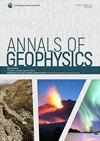Upper Mantle Anisotropy beneath Northern Algeria from Shear-Wave Splitting: Anisotropy beneath Northern Algeria
IF 1.2
4区 地球科学
Q3 GEOCHEMISTRY & GEOPHYSICS
引用次数: 1
Abstract
Northern Algeria is a large region in the north-western of Africa, lying on the collision boundary between the African and Eurasian plates. Few studies on Lithosphere and Mantle deformation have been conducted in this region. To better understand the seismic anisotropy patterns beneath this area, we used data from 17 broadband stations installed in Tellian and the Saharan atlases using the SKS shear wave splitting method by processing hundreds of teleseismic events. To estimate the seismic anisotropy, two parameters were calculated, the fast polarization direction and the delay time for each station-event pair. The results show that the seismic anisotropy can be described by two main orientations, ENE-WSW follows the general trend of the Saharan Atlas, particularly in the central and western parts, and ESE-WNW follows the Hodna Mountains in south-eastern Algeria. Our results show that the anisotropy can be explained by single and heterogeneity in the anisotropic structure, where the measurements are very scattered, and the delay time and fast direction changed with the events backazimuth. In the ABSD, CBBR and CDCN stations, which lie in the arc between the Sahara Atlas and the Aurès Mountains, the origin hypothesis of the seismic anisotropy can be linked to the existence of a detached slab. Moreover, in ABZH, OKGL and EARB stations located in the Kabylide and Western regions, it can be associated with the Gibraltar slab. Both slabs sinking in the African margin mantle were previously imaged by seismic tomography. For the remaining stations, the single-layer best explains the observed seismic anisotropy from their regular fast polarization direction. The comparison of the obtained fast directions with GPS measurements shows that anisotropy fast axes are nearly perpendicular to the convergence direction between the African and Eurasia plates.从剪切波分裂看阿尔及利亚北部的上地幔各向异性:阿尔及利亚北部的各向异性
阿尔及利亚北部是非洲西北部的大片地区,位于非洲板块和欧亚板块的碰撞边界上。对该地区岩石圈和地幔变形的研究较少。为了更好地了解该区域下的地震各向异性模式,我们使用SKS横波分裂方法,通过处理数百次远震事件,使用了安装在Tellian和撒哈拉地图集的17个宽带站的数据。为了估计地震各向异性,计算了每个站-事件对的快速极化方向和延迟时间两个参数。结果表明,地震各向异性可由两个主要方向来描述,ENE-WSW遵循撒哈拉地图集的总趋势,特别是在中部和西部,而ESE-WNW遵循阿尔及利亚东南部的Hodna山脉。结果表明,各向异性可以用单一性和非均质性来解释,在各向异性结构中,测量非常分散,延迟时间和快速方向随事件的反方位角而变化。在ABSD、CBBR和CDCN台站,这些台站位于撒哈拉大图集和aur山脉之间的弧形地带,地震各向异性的起源假设可以与分离板的存在联系起来。此外,在Kabylide和西部地区的ABZH、OKGL和EARB站,它可以与直布罗陀平板相联系。这两块在非洲边缘地幔下沉的板块以前都是用地震层析成像成像的。对于其余台站来说,单层台站从其规则的快速极化方向上最好地解释了观测到的地震各向异性。与GPS测量结果的比较表明,各向异性快速轴几乎垂直于非洲和欧亚板块之间的辐合方向。
本文章由计算机程序翻译,如有差异,请以英文原文为准。
求助全文
约1分钟内获得全文
求助全文
来源期刊

Annals of Geophysics
地学-地球化学与地球物理
CiteScore
2.40
自引率
0.00%
发文量
38
审稿时长
4-8 weeks
期刊介绍:
Annals of Geophysics is an international, peer-reviewed, open-access, online journal. Annals of Geophysics welcomes contributions on primary research on Seismology, Geodesy, Volcanology, Physics and Chemistry of the Earth, Oceanography and Climatology, Geomagnetism and Paleomagnetism, Geodynamics and Tectonophysics, Physics and Chemistry of the Atmosphere.
It provides:
-Open-access, freely accessible online (authors retain copyright)
-Fast publication times
-Peer review by expert, practicing researchers
-Free of charge publication
-Post-publication tools to indicate quality and impact
-Worldwide media coverage.
Annals of Geophysics is published by Istituto Nazionale di Geofisica e Vulcanologia (INGV), nonprofit public research institution.
 求助内容:
求助内容: 应助结果提醒方式:
应助结果提醒方式:


